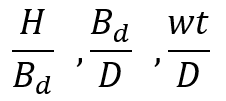API 1102: Pipeline Crossing Railroad
API 1102 – PC PISCES (Personal Computer Pipeline Soil Crossing Evaluation System) program is based on the design methodology resulting from the research and has been implemented in the program to aid pipeline designers in analyzing existing uncased pipelines and designing new uncased pipelines that cross beneath railroads. The details of the full design methodology can be found in “Technical Summary and Database for Guidelines for Pipelines Crossing Beneath Railroads” (GRI91, Final Report) and should be read and understood.
The design methodology used in program follows directly the approach given in API RP 1102. Concise summaries of the Cornell/GRI Guidelines are given in “Guidelines for Pipelines Crossing Beneath Railroads” (Stewart, et al., 1991b). API RP 1102 should be available to the user for additional documentation and preferences, and supplement the information provided by the program help and graphical display of the design curves.
This design methodology relates to:
MAXIMUM ALLOWABLE OPERATING PRESSURE.
SPECIFIED MINIMUM YIELD STRENGTH.
DESIGN FACTOR, (F).
LONGITUDINAL JOINT FACTOR.
INSTALLATION TEMPERATURE.
OPERATING TEMPERATURE.
WALL THICKNESS.
DEPTH OF CARRIER PIPE.
BORED DIAMETER.
SOIL TYPE FOR THE EARTH LOAD
MODULUS OF SOIL REACTION.
SOIL RESILIENT MODULUS.
SOIL UNIT WEIGHT.
TYPE OF LONGITUDINAL WELD
GIRTH WELD DISTANCE
NUMBERS OF TRACKS
E-TYPE RAIL LOADING
YOUNG’S MODULUS
POSSION’S RATIO
COEFFICIENT OF THERMAL EXPANSION.
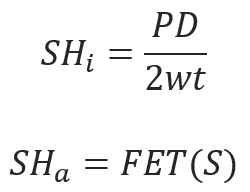
(see External Link: Barlow’s Formula in Wikipedia.com)

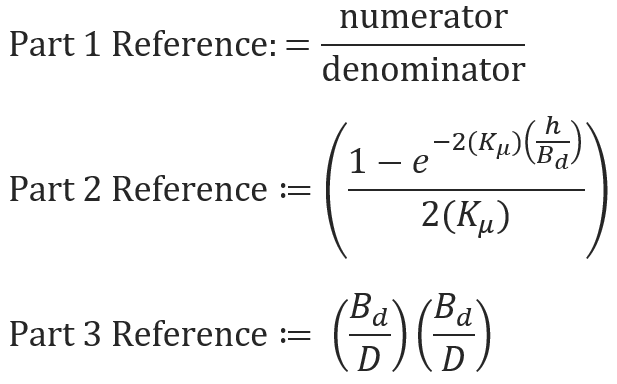

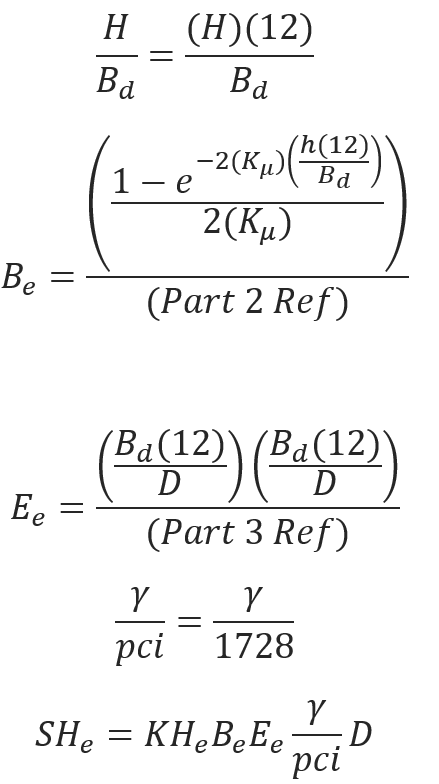
Step 4: Impact Factor and Applied Design Surface Pressure (F-Flexible, R-Rigid, N-None) (Case 1,2,3) Determine the Critical Load case and the applied surface design load. Find these values from Table Impact Factor: If Depth of Cover ≤ 5ft,1.75, = (1.75 – 0.03)(Cover – 5) NH – Railroad Double Track Factor for Circumferential Stress
NL – Railroad Double Track Factor for Longitudinal Stress
NH – Railroad Double Track Factor for Circumferential Stress
NL – Railroad Double Track Factor for Longitudinal Stress
Step 5: Cyclic Stress, 𝑫𝑺𝑯𝒉 & 𝑫𝑺𝑳𝒉
Reference the Design Curves in Appendix A from “Technical Summary and Database for Guidelines for Pipelines Crossing Beneath Railroads and Highways” (GRI-91/0285, Final Report)
Step 7: Principle Stresses 𝑺𝟏,𝑺𝟐,𝑺𝟑

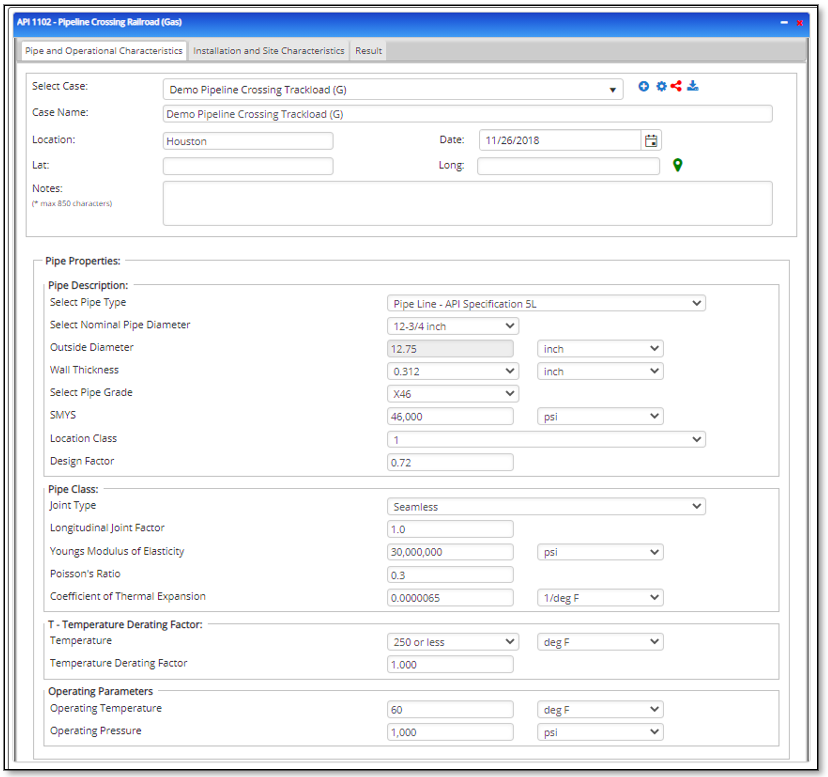
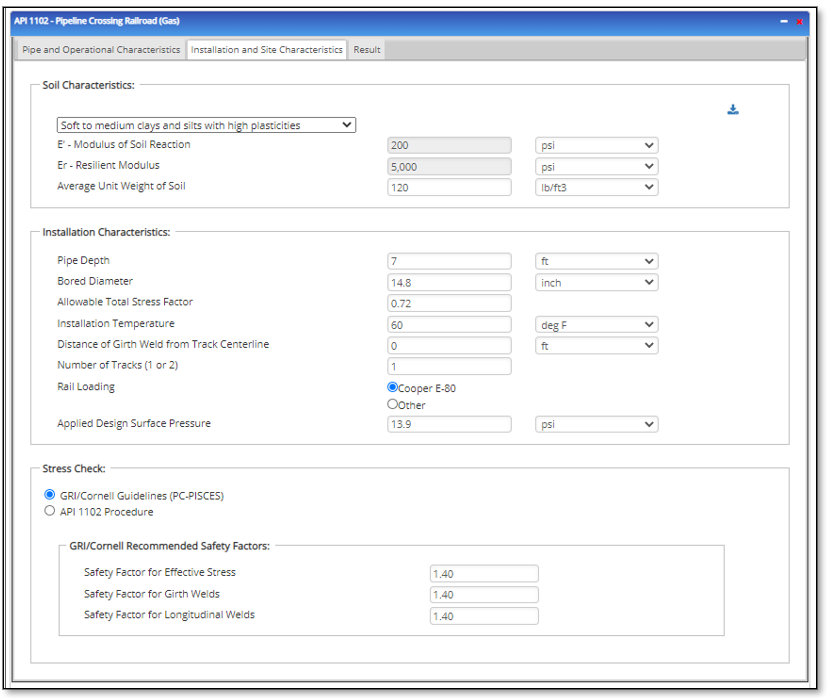
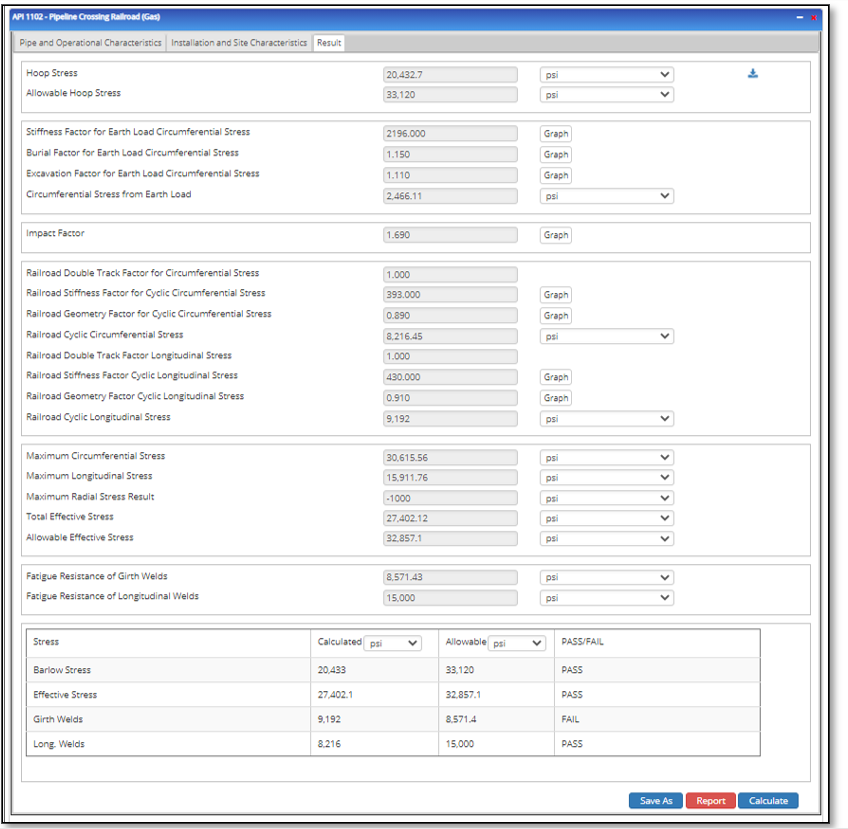
- Steel pipelines installed using trenchless construction methods, in particular auger boring, with the crossing perpendicular to the railroad.
- Pipelines having diameters 2 to 42 inches (51 to 1067 mm) can be analyzed.
- The wall thickness to diameter ratios must be within the range of tw/D = 0.01 to 0.08.
- Railroad crossings can be analyzed for depths of cover of 6 to 14 feet (1.8 to 4.3 meters).
- The loading condition for railroads is based for four axles distributed to the track surface
- Develops from the trailing and leading axles sets form sequential cars.
Variables and Boundary Conditions
Pipe Properties
DIAMETER.- The diameter, D, is the outside pipe diameter
- Has units of inches.
- The allowable range is from 2.000 to 42.000 in.
- The default value is D = 12.750 in.
MAXIMUM ALLOWABLE OPERATING PRESSURE.
- The maximum allowable operating pressure, MAOP, is used as the design internal pressure for calculating circumferential stress due to internal pressurization,
- Has units of psi,
- The allowable range is from 0 to 5,000 psig.
SPECIFIED MINIMUM YIELD STRENGTH.
- The specified minimum yield strength, SMYS,
- Has units of pounds per square inch (psi)
- Has a range of allowable values covering steel grades A25 (SMYS = 25000 psi) to X-80 (SMYS = 80000 psi).
- The SMYS is also used to establish the girth and longitudinal weld fatigue endurance limits.
DESIGN FACTOR, (F).
- Although 49 CFR 192 or 195, establishes a design factor, F, the user can input another F value.
- The allowable range is from 0.10 to 1.00.
- The default design factor is F = 0.72.
LONGITUDINAL JOINT FACTOR.
- The longitudinal joint factor, E, depends on the type of pipe welds.
- The input screen limits E to either 0.60, 0.80, or 1.00, consistent with the values given in 49CFR192, Section 192.113.
- The default value is E = 1.00.
INSTALLATION TEMPERATURE.
- The installation temperature, T1 is given in degrees Fahrenheit (°F).
- This value is used with T2 to determine thermal stress effects.
- The allowable range is from -20 to 450 °F.
OPERATING TEMPERATURE.
- The operating temperature, T2 is give in degrees Fahrenheit (°F).
- The T2 value is used to determine the temperature derating factor, T.
- T2 also is used with T1 to determine thermal stress effects.
- The allowable range is from -20 to 450 °F.
WALL THICKNESS.
- The pipe wall thickness, wt. has units of inches.
- The wall thickness to diameter ratios must be within the range of wt./D = 0.01 to 0.08.
DEPTH OF CARRIER PIPE.
- The depth of the carrier pipe, H, is measured from the top of tie to the pipeline crown for railroads.
- Has units of feet (ft)
- Is used to establish the impact factor, Fi used in the design methodology.
- The allowable range for the live load design curves is from 6ft <= H <= 14 ft for railroads
BORED DIAMETER.
- The bored diameter, Bd (Bd in RP 1102), has units of inches.
- The minimum value is Bd = D, and the maximum value is Bd = D + 6 in.
- The default value is Bd = D + 2 in.
SOIL TYPE FOR THE EARTH LOAD
- The soil type for the earth load calculations is either A or B. See Figure 4 in API RP 1102.
MODULUS OF SOIL REACTION.
- The modulus of soil reaction, E’, has units of ksi.
- The minimum value allowed is E’ = 0.2 ksi, and the maximum input value for E’ is 8.0 ksi.
- The maximum recommended value for auger bored installations is E’ = 2.0 ksi.
- When an E’ value greater than 2.0 ksi is used, a warning will be displayed that the value is beyond the normal range of E’ for auger bored installations.
- See details in API RP 1102.
SOIL RESILIENT MODULUS.
- The soil resilient modulus, Er has units of ksi.
- The minimum allowable value for the live load design curves is Er = 5.00 ksi, and the maximum allowable value is Er = 20.0 ksi.
- See Table 3 in API RP 1102
- The default value is Er = 10.0 ksi, as recommended in API RP 1102.
SOIL UNIT WEIGHT.
- The soil unit weight, r, has units of pcf,
- The allowable range is from 0 to 150 pcf.
- The default value is r = 120 pcf.
TYPE OF LONGITUDINAL WELD
- The type of longitudinal weld is used with the SMYS to establish the longitudinal weld fatigue endurance limit, SFL.
- The choices for the type of longitudinal seam weld are SAW or ERW.
- See Table 3 in API RP 1102 for the influence of longitudinal weld type and SMYS on the seam weld fatigue endurance limits.
- The default type of longitudinal weld is SAW.
GIRTH WELD DISTANCE
- The girth weld distance, LG, is used to determine the longitudinal stress reduction factor, RF, needed for the girth weld fatigue calculations.
- has units of feet
- The allowable values range from 0 to 99 ft.
- When a double track crossing is being analyzed, the recommended value for LG is less than 5 ft.
- For LG less than 5 ft, longitudinal stress reduction factors are not used.
- See Figure 18 A and 18 B in API RP 1102 for the RF values as dependent on LG, H, and D.
NUMBERS OF TRACKS
- The number of tracks, Nt, is used to determine whether a single or double track railroad crossing will be analyzed.
- The Nt value determines the NH and NL factors for circumferential and longitudinal live load pipelines stresses, respectively.
- The default value is Nt = 1.
E-TYPE RAIL LOADING
- The E – Type rail loading is used to determine the applied surface stress, w, for railroad crossings.
- The allowable range is from 0 to 99.
- Can also be entered, which causes the surface load, w, to be 1.0 psi.
- The default value is E – 80 loading, as recommended in API RP 1102.
YOUNG’S MODULUS
- Young’s modulus of the steel carrier pipe, Es (Es in RP 1102), has units of ksi.
- The allowable values range from 29,000 to 31,000 ksi.
- The default value is Es = 30,000 ksi.
POSSION’S RATIO
- Possion’s ratio of the steel carrier pipe, s, is used to assess thermal and longitudinal stresses due to the circumferential earth load and internal pressure stresses.
- The allowable values range from 0.25 to 0.30.
- The default value is s = 0.30.
COEFFICIENT OF THERMAL EXPANSION.
- The coefficient of thermal expansion of the steel carrier pipe T, is given for temperature in °F, and is used to assess longitudinal thermal stresses.
- The range is from 0.0000060 to 0.0000080 per F.
- The default value is T = 0.0000065 per °F.
Workflow
Step 1: Check wall thickness for the operation pressure. To continue wt > wtd- wtd – Wall Thickness Minimum [in]
- wt – Wall Thickness Actual [in]
- D – Pipe Diameter [in]
- S – Specified Minimum Yield Strength [psi]
- P – Design Pressure [psi]
- F – Design Factor
- E – Longitudinal Joint Factor
- T – Temperature Derating Factor

(see External Link: Barlow’s Formula in Wikipedia.com)
Step 3: Circumferential stress due to Earth Load
Soil type – Default Value: (Kμ= 0.165 for Soil Type A, Kμ= 0.192 for Soil Type B)
𝐻 − Pipe Depth[ft]
𝐵𝑑 − Bored Diameter[in]
𝐸𝑝𝑟𝑖𝑚𝑒 − Modulus of Soil Reaction
𝐸𝑟 − Resilient Module
𝛾 − Average unit weight of soil
𝐸𝑠 − Young′s Modulus of Elasticity



Step 4: Impact Factor and Applied Design Surface Pressure (F-Flexible, R-Rigid, N-None) (Case 1,2,3) Determine the Critical Load case and the applied surface design load. Find these values from Table Impact Factor: If Depth of Cover ≤ 5ft,1.75, = (1.75 – 0.03)(Cover – 5)
 NH – Railroad Double Track Factor for Circumferential Stress
NL – Railroad Double Track Factor for Longitudinal Stress
NH – Railroad Double Track Factor for Circumferential Stress
NL – Railroad Double Track Factor for Longitudinal Stress
Step 5: Cyclic Stress, 𝑫𝑺𝑯𝒉 & 𝑫𝑺𝑳𝒉
Reference the Design Curves in Appendix A from “Technical Summary and Database for Guidelines for Pipelines Crossing Beneath Railroads and Highways” (GRI-91/0285, Final Report)
𝐾𝐻𝑟 − Railroad Stiffness Factor for Cyclic Circumferential Stress
𝐺𝐻𝑟 − Railroad Geometry Factor for Cyclic Circumferential Stress
𝐷𝑆𝐻𝑟 − Cyclic Circumferential Stress
𝐾𝐿𝑟 − Railroad Stiffness Factor for Cyclic Longitudinal Stress
𝐺𝐿𝑟 − Railroad Geometry Factor for Cyclic Longitudinal Stress
𝐷𝑆𝐿𝑟 − Cyclic Longitudinal Stress
Step 6: Circumferential Stress due to Internal Pressurization Shi
Step 7: Principle Stresses 𝑺𝟏,𝑺𝟐,𝑺𝟑

Input Parameters
- To create a new case, click the “Add Case” button
- Select the API 1102 Gas Pipeline Crossing – Railroad application from the Pipeline Crossing module.
- Enter Case Name, Location, Date and any necessary notes.
- Fill out all required fields.
- Make sure the values you are inputting are in the correct units.
- Click the CALCULATE button.
- Pipe Type
- Nominal Pipe Size(in):(1/8” – 48”)
- Pipe Outside Diameter(in):(0.625” – 48”)
- Pipe Wall Thickness(in):(0.068”- >2”)
- Young’s Modulus of Elasticity:(29000000psi – 30000000psi)
- Poisson’s Ratio (-1 – 0.5)
- Thermal Expansion Coefficient(1/°F) :(0.0000022in/inF – 0.000012in/inF)
- Joint Type
- Location Class: Refer 49 CFR 192.5
- Operating Pressure
- Operating Temperature
- Specified Minimum Yield Stress:(24000psi-80000psi)
- Design Factor: Reference 49 CFR 192.611
- Longitudinal Joint Factor
- Temperature Derating Factor
- Modulus of Soil Reaction
- Resilient Modulus
- Average unit weight of Soil:(70lb/ft3 – 150lb/ft3)
- Pipe Depth
- Bored Diameter
- Installation Temperature
- Distance of Girth Weld from Track Centerline
- Number of Tracks
- Rail Loading
- Applied Design surface Pressure
- Safety Factor for Effective Stress
- Safety Factor for Girth Welds
- Safety Factor for Longitudinal Welds


Outputs/Reports
- View the results.
- If an input parameter needs to be edited be sure to hit the CALCULATE button after the change.
- To SAVE, fill out all required case details then click the SAVE button.
- To rename an existing file, click the SAVE As button. Provide all case info then click SAVE.
- To generate a REPORT, click the REPORT button.
- The user may export the Case/Report by clicking the Export to Excel/PowerPoint icon.
- To delete a case, click the DELETE icon near the top of the widget.
- Hoop Stress
- Allowable Hoop Stress
- Stiffness Factor for Earth Load Circumferential Stress
- Burial Factor for Earth Load Circumferential Stress
- Excavation Factor for Earth Load Circumferential Stress
- Circumferential Stress from Earth Load
- Impact Factor
- Railroad Double Track Factor for Circumferential Stress
- Railroad Stiffness Factor for Cyclic Circumferential Stress
- Railroad Geometry Factor for Cyclic Circumferential Stress
- Railroad Cyclic Circumferential Stress
- Railroad Double track factor for Longitudinal Stress
- Railroad Stiffness Factor for Cyclic Longitudinal Stress
- Railroad Geometry Factor for Cyclic Longitudinal Stress
- Railroad Cyclic Longitudinal Stress
- Maximum Circumferential Stress
- Maximum Longitudinal Stress
- Maximum Radial Stress
- Total Effective Stress
- Allowable Effective Stress
- Fatigue Resistance of Girth Welds
- Fatigue Resistance of Longitudinal Welds
- Barlow Stress
- Effective Stress
- Girth Welds
- Long Welds


